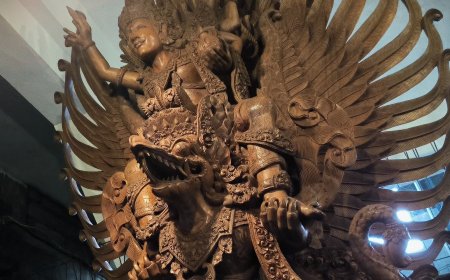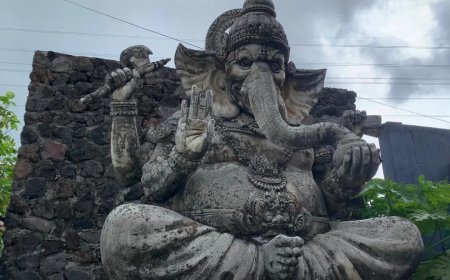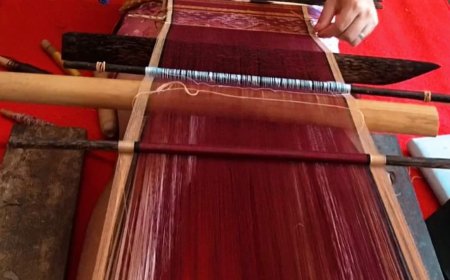Brahma Lelare: Sacred Baby Statue with a Very Haunted Aura
The Brahma Lelare statue, the most famous baby statue in Bali, is one of the statues that is highly recognized for its sacredness. This statue in the shape of a baby, 6 meters high and 4 meters wide, was used as a place of worship for the God Brahma as Ida Bhatara Wisesaning Jagat. The existence of the Brahma Lelare statue is highly interpreted so that deep meanings are prioritized in the process of making it, such as the meaning of the placement location, position of the statue, the day the first stone was laid, the origin of the stone used, and the location where the model was made. On certain days, this statue will give a mystical aura and story, for example, the sound of a baby crying and the eyes of the statue which are believed to be able to look to the right and left.

A statue is a three-dimensional work of art that is carved or made by humans by imitating the shape of creatures like humans or imitating other forms. One of the most famous statues in Bali, specifically in Gianyar Regency, a regency known as the city of art, is the Brahma Lelare statue. The Brahma Lelare statue is located at the T-junction of Sakah Roadway, Batuan Kaler Village, Sukawati District, Gianyar Regency. This location connects Gianyar City Roadway with Mas Roadway towards the Ubud Gianyar Tourist Area. Because its shape resembles a baby and its location on Sakah Roadway, this statue is also commonly referred to as the Baby statue, Sakah statue, or Baby Sakah statue.
The word "Brahma" in Brahma Lelare refers to the omnipotence of Ida Sang Hyang Widhi Wasa in creating, while the word "Lelare" is a word in Balinese that gets the prefix "Le" with the root word "Lare" which means little child. The Brahma Lelare statue depicts the manifestation of the all-powerful Ida Sang Hyang Widhi Wasa in carrying out creation which was then connected to the God Brahma as one of the Tri Murti Gods, namely as the creator god. Apart from its role in providing aesthetic value, the Brahma Lelare statue is also used as a place of worship aimed at the God Brahma as Ida Bhatara Wisesaning Jagat.
The Brahma Lelare statue was built due to instructions from Tjokorda Raka Dherana, SH as Regent of Gianyar for the 1983-1993 period. It was stated that statues would be built at several crossroads and T-junctions in Gianyar Regency whose shapes would be adapted to the tastes of the local community. At that time, Brahma Lelare was chosen to be made into a statue because the idea came from the late Ida Bagus Putera, who was a friend and someone who still had a close family relationship with the initiator of the construction of the Brahma Lelare Statue, Ida Bagus Mangku Ambara. The idea in question came from the late's dream about a small baby statue which became known as Brahma Lelare.

Side View of the Brahma Lelare Statue (Photo Source: Private Collection)
The Brahma Lelare statue would be very valid if it was said to be a statue with a very deep meaning. This is because every detail of the creation, whether from the location of the placement, the statue position, the day the first stone was laid, the origin of the positioning stone used, and the location where the mock-up is made are all chosen by prioritizing the meanings to be achieved. If you look at the location of its placement, initially this statue was placed in front of the Taman Pule Pakraman Mas Temple. Because the location is less historic and not located at a crossroad (catuspata) or T-junction as desired in the Gianyar Regent's instructions, the next location chosen was Banjar Blahtanah. Banjar Blahtanah was chosen as the location for placing the Brahma Lelare statue because of its connection with the existence of the Hyang Tiba Temple which is located to the west of the statue which is believed to be the place where the gods and goddesses descended from heaven. Right at the point where this statue was built, previously there was a triangular-shaped mound of earth containing a small pelinggih. Instead of being destroyed, the pelinggih, called the Dugul pelinggih, was left in existence and used as the base of the Brahma Lelare statue.
The process of making the statue began at the end of 1989 and was completed in March 1990. This means that it took around 90 days or three months to complete this 13-ton statue. The Brahma Lelare statue is about 6 meters high with a width of about 4 meters and takes a position facing south which symbolizes the cardinal direction of the God Brahma. Based on the Balinese calendar, the piodalan (one of the Hindu religious ceremonies) on this statue falls on Anggarakasih (Tuesday) Kliwon wuku Medangsia. This day is also the day of laying the first stone or ngawit mepulung dasar which coincides with the piodalan at Dalem Pakraman Mas Temple. This temple is a temple used to worship Ida Bhatara Shiva and Goddess Durga. This day was chosen as the day for laying the first stone because of the hope that the teja (holy light) from God Shiva would shine on the sacred Brahma Lelare statue that was to be built.
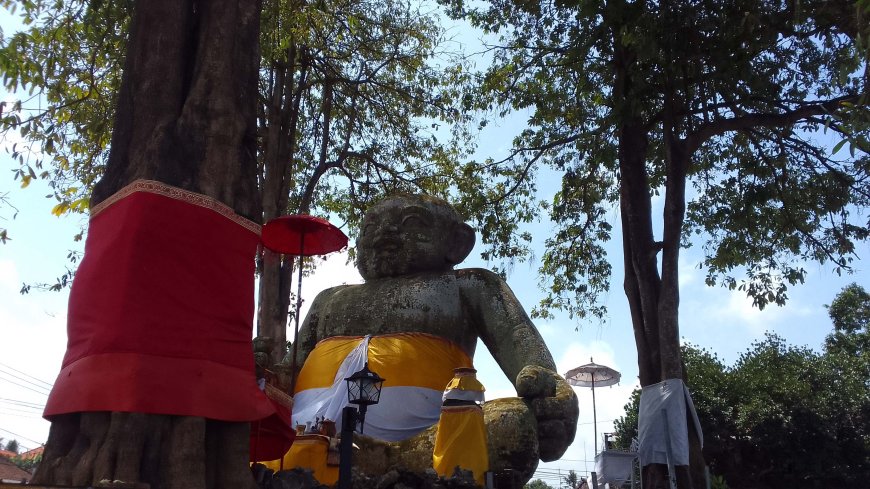
Side View of the Brahma Lelare Statue with Three Pule Trees (Photo Source: Private Collection)
The Brahma Lelare statue uses a cadas rock as the basic material obtained from the Petanu River in Bedulu Village, Gianyar Regency. This cadas rock from the Petanu River was chosen because it is considered to have supernatural value which is closely related to the legend of King Mayadenawa. At that time King Mayadenawa was killed by an arrow from God Indra, and the blood from the King is believed to have flowed into the Petanu River, causing the surrounding rice to turn red because it was irrigated by water mixed with blood. Therefore, the red color which is synonymous with Lord Brahma is the reason why they chose cadas rocks from this location. The seat of Brahma Lelare is composed of chunks of coral obtained from Geger Temple Beach in Sawangan Village, Nusa Dua which represents the symbol of the earth's bones. The choice of these materials was made to represent mountainous elements (cadas rocks) and oceanic or sea elements (coral rocks).
The mock-up of the Brahma Lelare statue was made in a quite famous temple, namely Masceti Temple. This location is believed to provide holy light when the replica or statue model is being worked on. Remember that the word "Mas" in Masceti means golden light and "Ceti" means light from Sang Hyang Widhi. The Brahma Lelare statue further depicts a baby sitting upright with two hands placed on his thighs. More specifically, the right hand is placed on the thigh with the clenched fist facing forward as the direction of creation. The fingers of the left hand are attached to the left thigh which is a symbol of supporting the body upright. Both legs are in a cross-legged position and the ends meet each other. This statue can be divided into three parts which represent the three worlds called the Tri Loka. The bald part of the head symbolizes the realm of "Svah" or the realm of the gods. The body part symbolizes the human realm, namely "Bvah", and the last part is the part around the feet which represents the "Bhur" realm. His fat body with a bulging stomach has a rotation similar to that of God Ganesha who provides protection to his bhakta (devotees). This statue is surrounded by 3 large pule trees, each covered with a red, yellow, and white cloth. This color is often associated with the God Tri Murti, namely God Brahma as the creator, God Vishnu as the preserver, and God Shiva as the pralina (melter).
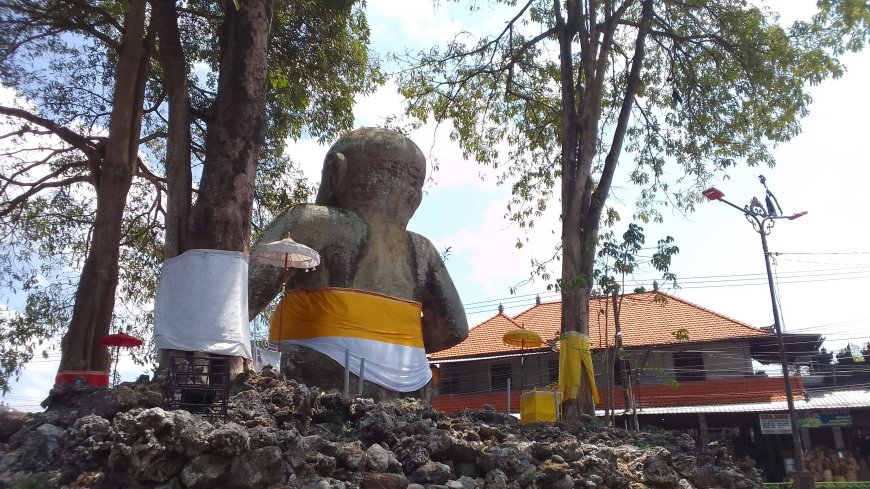
Back View of the Brahma Lelare Statue with Three Pule Trees (Photo Source: Private Collection)
Not all statues, especially statues in Bali, are used as a medium for worship. For example, if a work of art represents a certain symbol, its sacredness will not be believed if it does not go through a spiritual ceremony process. Generally, the statues at T-junctions or intersections in Bali in the form of guard statues (bhuta) are erected with the aim of guarding the place to avoid traffic accidents, as well as to provide a sense of security to the people around it. The Brahma Lelare statue was built with the aim of being sacred. So there are eedan (sequence) of religious ceremonies that must be carried out completely to convey their sacredness. The eedan ceremony referred to is that you have to go through Mulang Dasar, Nanem Pendeman (pancadatu), Pengurip, Melaspas, Pasupati, and Piodalan.
Local people and even residents outside Batuan Kaler Village really respect the sacredness of this statue. There are quite a lot of residents outside the village who deliberately pray at the Brahma Lelare statue to ask for sons for those who have not been blessed with children. There are also several medical shamans who often pray to ask for supernatural powers to carry out their traditional treatments. Mystical stories also often occur, for example, there is the sound of a baby crying on certain days and the eyes of a statue which is believed to be able to look to the right and left.






































